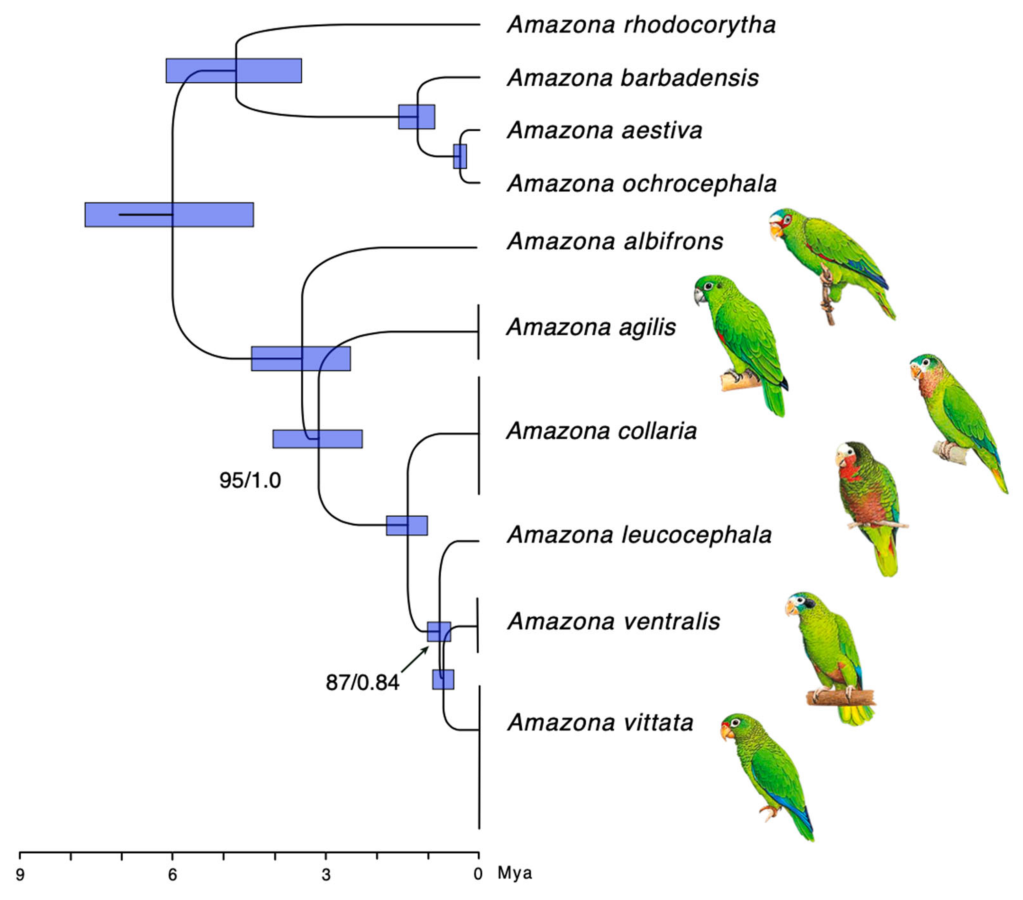Mitochondrial DNA points to a stepping-stone scenario from Jamaica to Puerto Rico.
Islands have often been described as “natural laboratories” for evolutionary biologists. But before evolution can start tinkering with the available genetic variation of newly founded island populations, organisms first need to reach and spread across these archipelagos. Reconstructing the chain of colonization of an island group is no easy exercise. A nice example of this challenge concerns Amazon Parrots on the Greater Antilles (an archipelago in the Caribbean Sea including Cuba, Hispaniola, Puerto Rico, Jamaica, and the Cayman Islands). This collection of islands houses five species of Amazon Parrot:
- The Cuban Amazon (Amazona leucocephala) on Cuba
- The Black-billed Amazon (Amazona agilis) on Jamaica
- The Yellow-billed Amazon (Amazona collaria) on Jamaica
- The Hispaniolan Amazon (Amazona ventralis) on Hispaniola
- The Puerto Rican Amazon (Amazona vittata) on Puerto Rico
Ornithologists have been speculating about the evolutionary history of these parrots. Patricia Ottens-Wainright and her colleagues suggested that there may have been two independent dispersal events to the Greater Antilles. David Lack, however, argued for a single colonization event based on the morphological similarities between the Cuban Amazon, the Hispaniolan Amazon and the Puerto Rican Amazon. A recent study in the journal Genes attempted to resolve this debate by sequencing the complete mitochondrial genomes of all five species.
A Phylogeny of Parrots
First, Sofiia Kolchanova and her colleagues reconstructed the phylogenetic relationships among the parrots on the Greater Antilles and their South and Central American cousins. These analyses revealed that the five species from the Greater Antilles form a distinct cluster that is sister to the White-fronted Amazon (Amazona albifrons), a species from Central America. This finding suggests that the Greater Antilles were colonized only once, arriving on Jamaica. But how did these parrots subsequently spread across the islands? To answer this question, the researchers explored several biogeographic models with the R-package BioGeoBEARS.

Stepping Stones
All biogeographic models indicated that the ancestor of Amazon Parrots on the Greater Antilles reached Jamaica about 3.5 million years ago. This date coincides with a period of low sea levels when birds could easily reach the islands from the Central American mainland. About 3.1 million years ago, the founding population on Jamaica split into two species: the Black-billed Amazon and the ancestor of the four other species. However, it is unclear what happened next. Some models indicated that the speciation event happened on the same island (i.e. sympatric speciation), giving rise to the Yellow-billed Amazon. Roughly 1.4 million years ago, part of this population colonized Cuba. However, other models pointed to an allopatric speciation event after dispersal to Cuba (or some islands that have now disappeared). Later on, some of these Cuban birds returned to Jamaica and evolved into the Yellow-billed Amazon. More detailed analyses – with nuclear genetic data – are needed to discriminate between these scenarios.
The remainder of the evolutionary story of these parrots is more clear. The researchers write that “most models agree that once the parrots reached Cuba, they have continued to disperse to Hispaniola and then to Puerto Rico in a stepping stone fashion.” The colonization of Hispaniola occurred ca. 760,000 years ago while Puerto Rico was reached about 690,000 years ago. However, it is important to keep in mind that this scenario, and the accompanying dates, is solely based on mitochondrial DNA. Analyses of the whole nuclear genome might tell a slightly different story. Although it seems almost certain that the Greater Antilles were colonized once by these parrots. David Lack was right.

References
Kolchanova, S., Komissarov, A., Kliver, S., Mazo-Vargas, A., Afanador, Y., Velez-Valentín, J., … & Oleksyk, T. K. (2021). Molecular phylogeny and evolution of Amazon parrots in the Greater Antilles. Genes, 12(4), 608.
Featured image: Cuban Amazon (Amazona leucocephala) © Laura Gooch | Wikimedia Commons

Is it known how the 2 subspecies of Cuban Amazon found on the Cayman Islands fit into this arrangement, and are the amazon species in the Lesser Antilles the result of an independent colonisation event?
The parrots on Grand Cayman and Cayman Brac are most likely blown there from Cuba. These are subspecies, part of the recent expansion of parrots from Cuba, now found on many islands from the Bahamas to the Caymans. In the study we did not have the DNA from them so we could time the expansion.
The parrots on Grand Cayman and Cayman Brac are most likely blown there from Cuba. These are subspecies, part of the recent expansion of parrots from Cuba, now found on many islands from the Bahamas to the Caymans. In the study we did not have the DNA from them so we could time the expansion.
The parrot species in the Lesser Antilles expanded from South America. There may have been several colonizations there.